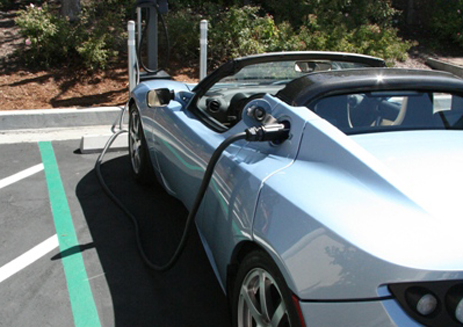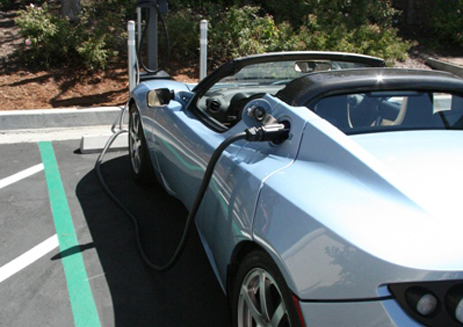 A Tesla Roadster gets a boost from a SolarCity charging station in SalinasPhoto courtesy SolarCityYou can’t get more California greenin’ than this.
A Tesla Roadster gets a boost from a SolarCity charging station in SalinasPhoto courtesy SolarCityYou can’t get more California greenin’ than this.
Peter Rive can charge up his Tesla Roadster electric sports car in his San Francisco garage with carbon-free electricity supplied by a solar array on his roof. Then, if he’s in the mood for a road trip, he can drive to Los Angeles, stopping at a solar-powered charging station along the way to top off the battery.
The free charging stations on the “solar highway” — aka the 101 — were recently installed by SolarCity, the Silicon Valley rooftop solar company Rive founded with his brother Lyndon. (The electric-blue Roadster sitting in his garage was made by his cousin Elon Musk‘s startup, Tesla Motors.)
So what’s a solar company doing installing highway charging stations for six-figure sports cars driven by people with seven-figure salaries?
In part, it’s a result of SolarCity’s connection to Tesla and grants the electric carmaker received from the state of California to demo charging stations. It makes for great PR, of course, but the bigger picture here is how the emerging electric vehicle industry will drive (sorry) the adoption of residential and commercial photovoltaic systems.
“It’s our feeling that if we really want to make a difference, we have to start changing our infrastructure,” says Lyndon Rive, SolarCity’s chief executive. “Combine EV with PV, and we can really lead a clean lifestyle.” (Jargon watch: That’s “EV” for electric vehicles, and “PV” for photovoltaic solar energy.)
It’s also good for business.
SolarCity earlier this month completed the acquisition of SolSource Energy, a Los Angeles company that installs electric car charging stations in homes and at businesses. So far, SolarCity has installed about 100 charging stations for Tesla customers but expects those numbers to skyrocket once automakers start introducing electric cars to the mass market over the next few years.
“That business does have potential for humongous growth,” says Rive. “We’ve only deployed about 65,000 solar systems in the U.S., but you’re talking about hundreds of thousands of electric cars over the next five years.”
And once you have an EV in your garage, it makes more economic sense to put PV on the roof to supply the electricity. When you’re getting free fuel from the sun for your car, you accelerate return on investment for the solar array. And, of course, you’ll need a bigger solar system, which means bigger profits for installers like SolarCity.
“If you sell 50,000 cars and get 50 percent adoption rate for PV, it’s very significant,” notes Rive. “A lot of customers who have just bought an EV decide to get a solar system as well or vice a versa.”
And when employees start arriving at work expecting to plug in before they log on, companies will have another compelling reason to go solar.
As electric cars go mass market in places like California, PG&E, Southern California Edison and other utilities will likely ramp up efforts to install distributed solar systems to ease the load on the electricity grid and avoid having to build fossil fuel power plants to meet peak demand.
That evolving solar ecosystem can be seen at Peter Rive’s home on a steep San Francisco street with a view of the downtown skyline. On the roof sits a three-kilowatt solar panel array. Although Rive, Solarcity’s chief operating officer, just recently took delivery of his Tesla Roadster, he planned for the car’s electricity consumption when he installed solar panels and upgraded his home’s electrical system a year and a half ago. (Something you, Grist readers, should consider if you are contemplating going solar and may buy an electric car one day.)
“This is the equivalent load of an air conditioner,” says Rive, nodding at his new toy.
The fast-charge station is a square box attached to the wall by the garage. Installation, adds London Rive, “runs between $2,000 and $6,000,” depending on whether an electric system upgrade is needed. The system can charge a depleted battery in about three-and-a-half hours.
“It’s sort of like your cell phone — you use it during the day and plug it in at night and forget about it,” says Rive, taking the heavy-duty cord with a nozzle-like attachment and plugging it into the Roadster’s charge port.
The solar system’s control panel shows that the rooftop panels are generating more electricity at the moment than the house is consuming. “I generate enough solar during the day to offset my commute,” Rive says.
Whether Tesla owners will abandon their private jets or flying first class in favor of driving their Roadsters up and down the California coast is another matter. But the way SolarCity has designed its charging station network points to the future convergence between the roof and the road.
Four of the five fast-charging stations the company built are located at branches of Rabobank, a Dutch-owned bank with 91 branches in California, many of them located along the 101 corridor. The single solar-powered charging station — there are plans to solarize three others — draws its electricity from a 30-kilowatt array previously installed by SolarCity at the bank’s Santa Maria branch on the central coast.
The charging stations currently are only compatible with Tesla’s vehicles, but will eventually add a port to charge other electric cars. (Better Place, Coulomb Technologies and Ecotality are among other startups with plans to electrify the interstate.)
“You don’t want solar to be a stand-alone unit,” says Lyndon Rive. “By the time you stop to use this corridor, it’s been feeding electricity to the grid all day long. But when you plug in your car, it will use less than those panels produced during the day.”
More on the web:
- Charging station network built along Highway 101 (S.F. Chronicle)
- Electric Vehicle Charging Stations – What The EV World Needs Now (Automobile Magazine)
- California E.V. Corridor Is Open for Business (N.Y. Times)



